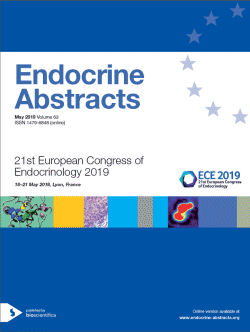Searchable abstracts of presentations at key conferences in endocrinology

21st European Congress of Endocrinology
Lyon,
France
18 May 2019 - 21 May 2019
18-21 May 2019, Lyon, France
Symposia
Innovations in NETs
ea0063s14.1 | Innovations in NETs | ECE2019
Innovative imaging of benign insulinomas – the end of sampling
Background: Benign insulinomas are the most prevalent cause of endogenous hyperinsulinaemic hypoglycaemia (EHH) in adults and due to their small size difficult to localise. Until now, the most sensitive test to localize the area of the potential insulinoma was the intra-arterial calcium stimulation test, an invasive procedure with its associated risk. In contrast to the other neuroendocrine tumors, benign insulinomas do not exhibit upregulated somatostatin receptors sutype 2 (...
ea0063s14.2 | Innovations in NETs | ECE2019
A role for radionuclide therapy for high-grade NETs
Background: Peptide receptor radionuclide therapy (PRRT) is an established treatment of metastatic low-grade and intermediate-grade neuroendocrine tumors (G1-G2). However, its possible benefit in high-grade gastroenteropancreatic (GEP) neuroendocrine neoplasms (NEN G3: NET G3 and NEC) has been unknown.Methods: Data from 3 recent retrospective studies (Thang et al. 2018, Zhang et al. 2018, Carlsen et al. 2019) on efficacy and to...
ea0063s14.3 | Innovations in NETs | ECE2019
Fishing for NETs
Neuroendocrine tumors (NETs) are a class of rare and heterogeneous neoplasms derived from the neuroendocrine system. Animal models are indispensable tools for investigating the pathogenesis, mechanisms for tumour invasion and metastasis and new therapeutic approaches for cancer. Unfortunately, only few models are available for NETs, probably due to the rarity and heterogeneity of this group of neoplasms. The tropical teleost zebrafish (Danio rerio) is a popular vertebrate mode...



